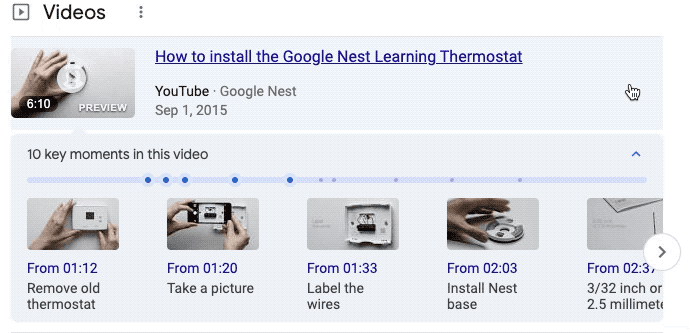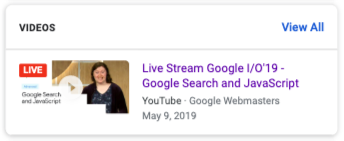Wednesday, May 12, 2021
Video is becoming increasingly common on ecommerce sites. As a site owner, you can use video to give shoppers a deeper understanding of products you sell or build your reputation as a trusted expert. Video can also be prominent in Google Search. By surfacing your video content on Google, you can open up additional paths of discovery to drive awareness of your business and engagement on your site.
Where videos can appear in Google Search results
Videos can appear on the main Google Search results page or on the Videos tab. Videos are frequently presented with a thumbnail image and other helpful information such as the playback duration and summary text. In addition, Google can now highlight key moments in your video content, allowing users to navigate the video like chapters in a book. When a user taps a key moment, they’ll land on your site where they can begin watching the video from that moment in time.

Common uses of video on ecommerce sites
Video can create deeply engaging experiences for shoppers on your ecommerce site and may help
people looking for relevant content from the Google Search page. Here are some common ways
you can use video on an ecommerce site:
Product Pages: Videos are frequently embedded in product pages, providing richer
inspirational or functional information about a product than by static images alone. For example,
inspirational content may show a happy family using a picnic basket in the park whereas functional
content may show how a baby stroller can collapse for easy storage. These kinds of videos can
prove useful to people on their shopping research journeys in Search.
Articles and Blog Posts: A site may also have articles and blog posts that include video
content. The video may share reviews comparing and evaluating products you sell, or share behind
the scenes stories on what makes your business special. Different types of content are useful to
different shoppers based on whether they are still researching or are ready to buy. Many shoppers
are also interested in your business itself, such as your position on recycling
or supporting your community.
Live Streaming: Advanced sites may also support embedded live streams with the ability for
viewers to interact with the host, creating deeper relationships with your customers. Live streams
can be scheduled in advance or created spur of the moment. Some video streaming services allow
live streams to be embedded in your pages, enabling you to leverage their infrastructure while
keeping customers on your own site. If your live stream is recorded, it can remain on your site as
a regular video, offering a longer shelf-life in Search for people looking for relevant content.
Video can be used in many other ways to support ecommerce, including in social media. When video
is hosted on a social media platform, the platform is responsible for making video available for
Google to index so you generally should not have to do any extra work.
Getting the most out of Google Search and Discover
The following tips can help Google index video content hosted on your ecommerce site. You may need
to find an appropriate plugin if using a CMS or ecommerce platform that does not give you direct
control over HTML markup:
-
Include
Videostructured data
on pages containing video content. This can be particularly important on product pages
with videos embedded in a media carousel as Google may not see videos that require user
interaction to display. -
For those videos that you want to give maximum exposure to, consider creating a page dedicated to the
video that describes the video content. A “how to clean your Brand X coffee maker” page may
attract different traffic than a Brand X product page that includes the how-to video along with
a lot of other information. It is fine to include the same video on both a dedicated page and
the product page. -

For live streams, include structured data to enable
LIVE badges,
which can help draw attention to the streams when they go live. Use the
Indexing API
to provide Google with timely updates when a stream starts and ends. A live stream recording
made available for viewing after the live event is not eligible for the LIVE badge. - Create and submit a video sitemap file to help Google find all your web pages with video content.
-
In addition to
Videostructured data, consider adding structured data that’s relevant for each page, such asProduct,HowTo, orQ&Amarkup.
For more information, check out
these new
resources that give an overview of how videos appear on Google, including
best practices
for sites with videos.
